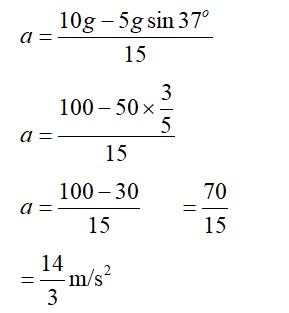A block of mass m = 1 kg slides with velocity v = 6 m/s on a frictionless horizontal surface and collides with a uniform vertical rod and sticks to it as shown. The rod is pivoted about O and swings as a result of the collision making angle θ before momentarily coming to rest. If the rod has mass M = 2 kg, and length l = 1 m, the value of θ is approximately: (take g = 10 m/s²)
A block of mass m = 1 kg slides with velocity v = 6 m/s on a frictionless horizontal surface and collides with a uniform vertical rod and sticks to it as shown. The rod is pivoted about O and swings as a result of the collision making angle θ before momentarily coming to rest. If the rod has mass M = 2 kg, and length l = 1 m, the value of θ is approximately: (take g = 10 m/s²)
Option 1 -
49
Option 2 -
55°
Option 3 -
69°
Option 4 -
63°
-
1 Answer
-
Correct Option - 4
Detailed Solution:By Conservation of Angular Momentum (COAM) about O, just before and after the collision:
Initial angular momentum L? = mv?
Final angular momentum L? = Iω? = (I_rod + I_block)ω? = (M? ²/3 + m? ²)ω?
L? = L?
mv? = (M? ²/3 + m? ²)ω?
ω? = mv / (M? /3 + m? ) = (16) / (21/3 + 1*1) = 6 / (5/3) = 18/5 rad/sBy Conservation of Total Mechanical Energy (COTME) after collision until it comes to rest:
Initial Energy (at the lowest point) = Rotational K.E. = (1/2)Iω? ²
Final Energy (at the highest point) = Potential Energy = mgh_m + Mg h_M
mgh_m = mg (? -? cosθ)
Mg h_M = Mg (? /2 - (? /2)co...more
Similar Questions for you
= 0.92 * 1260 = 1161 m/s
For 2 kg block
T – 2g sin37 = 2a . (i)
For 4 kg block
4g – 2T =
2g – T = a . (ii)
T = (2g – a)
2g – a – 2g × = 2a
3a = 2g ×
Taking an Exam? Selecting a College?
Get authentic answers from experts, students and alumni that you won't find anywhere else
Sign Up on ShikshaOn Shiksha, get access to
- 65k Colleges
- 1.2k Exams
- 679k Reviews
- 1800k Answers






